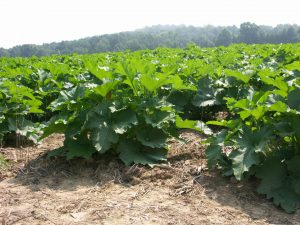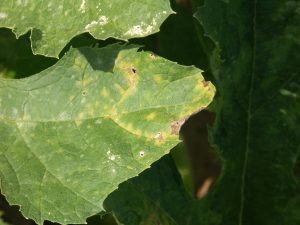I have received several calls about pumpkins recently. This article will outline a few steps growers should think about to prevent diseases in pumpkins.
Virus diseases – There are several virus diseases that affect pumpkins in the Midwest. The most important diseases include: papaya ring spot, watermelon mosaic and zucchini yellow mosaic virus. Aphids transmit all these diseases. Many of the aphids responsible are carried up from the south each year on winds. Therefore, aphids with virus are more common later in the summer; pumpkins planted later in the season are more likely to be affected with one of the virus diseases listed above. Plant pumpkins by about June 15 to avoid having the fruit set during the period of high virus disease pressure.
Powdery mildew – It is nearly impossible to find a pumpkin vine in August without powdery mildew. However, this disease does not have to affect production. The first decision a grower should make regarding powdery mildew of pumpkin is to choose, if at all possible, a variety with partial resistance to powdery mildew. Selected varieties with partial resistance are listed in the Midwest Vegetable Production Guide, mwveguide.org. Varieties that have partial resistance to powdery mildew may still require fungicides, however fewer fungicide applications will be required for disease control if the appropriate variety is chosen.
Fungicides should be applied for management of powdery mildew of pumpkin at about the ‘bush stage’ (Figure 1). The bush stage is the point where the pumpkin plant has grown up into an upright plant, shortly before vining starts. It is at this bush stage that high humidity inside the plant canopy favors powdery mildew development. (The fungus that causes powdery mildew requires high humidity, but not leaf wetness.)

Figure 1: Fungicides for management of powdery mildew should be applied when pumpkins have reach the ‘bush’ stage as seen here.
More information about fungicides for powdery mildew of pumpkin can be found at https://vegcropshotline.org/article/powdery-mildew-of-cucurbits/. Briefly, the following fungicides have proven effective: Aprovia Top®, Fontelis®, Luna Experience®, Inspire Super®, Merivon®, Quintec®, Procure, Rally®, Torino®. It is important to alternate the FRAC groups (aka, MOA groups) to avoid getting powdery mildew fungi that are resistant to these fungicides, but also for good control. The best treatments in my trials have been those that alternated fungicides of several different FRAC groups.
Downy mildew – Although the name of this disease is similar to powdery mildew, the disease is caused by an unrelated fungus-like organism. This fungus-like organism does not survive in the Midwest and must be blown in every year. Therefore, downy mildew is not observed in most years until August or September. Downy mildew causes an angular yellow lesion on the surface of the leaves and a dark, fussy appearing growth on the underside of the leaf (Figure 2 and 3). Watch the Hotline for updates to the occurrence of this disease around the eastern U.S. Do not apply expensive downy mildew products unless this disease has been observed close-by. As of this writing, downy mildew has not been observed in Indiana this year. More information about downy mildew of pumpkin can be found in this extension publication https://www.extension.purdue.edu/extmedia/BP/BP-140-W.pdf or this video https://www.youtube.com/watch?v=sz0vZ-t0gyg.

Figure 2: Downy mildew of pumpkin results in angular yellow lesions on the leaf surface. Downy mildew of cucurbits had not been reported in Indiana this season.

Figure 3: Downy mildew of pumpkin causes a ‘fuzzy’ fungus-like growth on the bottom of leaves under moist conditions.
Bacterial spot – This disease has become more important in the last several years. The bacterium that causes bacterial spot survives in crop residue and may be transmitted through seed or transplants. Crop rotations of 2 to 3 years out of cucurbits are important to manage this disease. However, many growers continue to have problems with bacterial spot even with good crop rotations. (Bacterial spot of tomato is a different disease caused by a different bacterium.)
The products I recommend for bacterial spot of pumpkin are copper mixed with a mancozeb product. Copper is a bacteriacide; mancozeb products allow more of the copper in copper based products to be available. These products should be applied 1) if the symptoms of bacterial spot are recognized on the seedling or young plant or 2) at the stage of the plant where fruit are about softball size. It is at about this stage that fruit are most susceptible to bacterial spot. As the fruit matures, the pores (known as stomates) in the surface of the fruit become blocked by a waxy type substance making the fruit less susceptible to bacterial spot.
Phytophthora blight – This disease affects many different crops including other cucurbits (See watermelon article in last Hotline issue) and solanaceous crops-especially pepper. The fungus-like organism that causes Phytophthora blight survives well in soil and spreads easily from leaf to leaf—a dangerous combination. (Yes, Phytophthora blight and downy mildew are caused by related fungus-like organisms and some of the same fungicides are effective against both.) A four-year crop rotation will help to reduce the severity of Phytophthora blight.
While Phytophthora blight of watermelon affects primarily fruit, this disease can affect fruit and vines of pumpkin plants. Thus, watermelon growers can wait until fruit set to start fungicide applications, pumpkin growers must worry about all stages of plant growth. This spring was relatively dry, therefore fungicide applications for Phytophthora blight may have been unnecessary. However, with the more recent wet weather, Phytophthora blight may become a problem. The fungus like organism that causes Phytophthora blight loves heavy rains and the pools and puddles that are left behind in poorly drained fields.
The fungicides that are effective against Phytophthora blight are the same as discussed https://vegcropshotline.org/article/phytophthora-fruit-rot-of-watermelon-2/. Also, see the Midwest Vegetable Production Guide at mwveguide.org.
The information above only outlines my ideas for disease management on a handful of pumpkin problems. Please contact me for more detailed information.